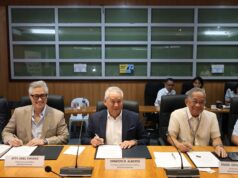AS TODAY’S Gen Z are so engrossed in enjoying their Lenten vacation in some “instagramable” and picture-perfect getaways, I couldn’t help but recall and compare how I always looked forward to spend the Holy Week in my hometown.
No, this is not some sort of a self-righteous or a “holier-than-thou” take on how today’s youth view and celebrate an important religious observance in the Christian world.
I grew up in Macabebe marveling at the liturgical and para-liturgical activities from Domingo de Ramos to Domingo de Pascua, overwhelmed by the pomp and pageantry of it all.
As a wide-eyed grader, my brother and I would choose only the best palm fronds and painstakingly make the palaspas that needed to be blessed on Palm Sunday. That meant waking up early, then go straight to the designated capilla where the rites began. I remember our cura parroco riding a horse in what was obviously a reenactment of Jesus’ entry to Jerusalem. He would stop in front of young girls dressed immaculately in white, perched on make-shift balconies along the main street. And right on cue, the girls would sing the Latin version of the Hosanna. My brother and I would then join our maternal aunt, called by many parishioners as one of the dagis pisamban, in the Mass that stretched to almost two hours. But we did not complaint at all; it was a badge of honor for us to bring home the blessed palms, distribute them to our neighbors and put them on their windows or main doors.
From Monday to Wednesday, there was no jumping, playing and horsing around. We were afraid to get hurt or even get the slightest bruise or scratch, believing that if we did, it would take a longer time to heal completely. The three days also meant taking our turns to “guard” our puni, or cenaculo to some. It was a well-designed mini-chapel built from various materials using funds collected from neighbors or donated by some friends. We took turns in singing the pasyon in three traditional Kapampangan melodies, a capella. In the evening, we served snacks to guests and some manangs who would also volunteer to sing the pasyon as their act of penance.
The Wednesday and Friday processions meant seeing the grand display of heirloom carrozas and life-size images dressed in the ornately embroidered vestments, followed by various parish lay organizations praying the rosary. In the absence of any gadget during that time, it meant being awed by a moving image right before your very eyes – a specific event in the Lord’s passion encapsulated in one carroza, complete with intricate flower arrangement and lights that make the images somewhat come to life.
There was no egg hunting on Easter Sunday, there never was as far as my hometown is concerned. The salubong was a sight to behold and an experience to relish. My brother and I would keep our breath as each petal from the bumbong unfolded. We would pray silently that the young girl dressed as an angel would, in one swift move, pull the black veil covering Mama Mary. Otherwise, the life and livelihood for our town would not be easy for the rest of year.
I think it was until the late 70’s when the Pakbung Hudas capped the Lenten celebration in our parish. After the Easter Sunday mass, an effigy of the apostle who betrayed Jesus was hung on a pole, complete with a replica of the bag containing the 30 pieces of silver coins he was given after he betrayed his Master. The crowd gathered at the main plaza would shout in jubilation as each part of the effigy exploded, culminating in the rotation of the head until it exploded. Looking back, it was a violent way to end the Holy Week. No wonder it was stopped, as it did not provide any significance to celebrate the promise and hope of the risen Lord.
Various activities are held all over the country in observance of the Holy Week. Some have been replaced and many have evolved so that as they continue to be a display of our rich tradition and culture, they remain anchored on the real meaning of Lent. As we participate in all these activities, let us never lose sight of the meaning of Lent. And as we enjoy this extended holiday, let us always be reminded, inspired and emboldened by the love of God who gave us His only Son so that we may live and have eternal life.





